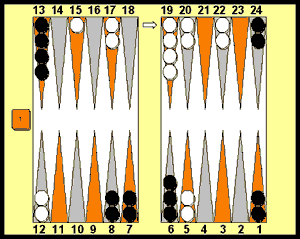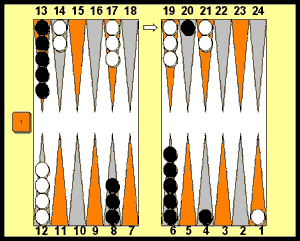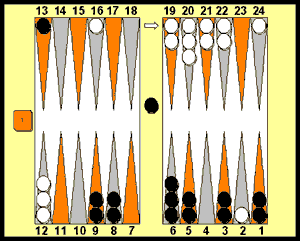
|
Cube Handling |

|
Be a PRAT |
| Alan Webb |
| 6 February 2000 |
Paul recommends to double when you have an advantage in two of these three areas. If you have a clear advantage in all three, then your opponents should pass. I just want to add a little more about the PRAT method. First of all, it is easy to remember as you just ask yourself not to be a "prat" on doubling decisions. (Prat, in English, is a derogatory term meaning idiot.) Since I read Paul Lamford's book, about six months ago now, I have used this method pretty extensively. I tested it recently against the doubling positions in Robertie's 501 Essential Backgammon Positions by not relying on experience but simply using the method described. I found that the results were impressive and I made a marked improvement from when I first tried them using just experience, especially in contact positions. I have tweaked the general principal slightly myself in that I attach weightings to each of the three main areas. Meaning, for example, if all things being equal, I will weigh the pip count (race) higher than the threat and position areas. I also take good account of the score in match play and gammon potential both ways. The method itself is not that much good to a real beginner, however, as you still need to know if your position is in fact better and still need to know if you have any threats and what they are. For those with a reasonable understanding of the game, say 1550+ I believe it can help a long way. It isn't perfect as there are some positions where other factors override the result of the method, in particular, prime vs prime positions, but it has helped my game along nicely and I'm making far fewer doubling errors than I used to. Just to illustrate things let's see the guidelines in action ...
From the above we gather that White has the better position, is ahead in the race and threatens to make the bar- or 4-point. So if we use the criteria that three areas in your favour should be double/pass, then the correct cube action must be double/pass. Snowie agrees ...
How about this one?
So White has two out of the three areas which, according to the general rule, is a double/take. Snowie says ...
Last but not least:
So what we have here is two out of three of the areas so, according to the guideline, this is a double/take right? Wrong!
This is why you should only use PRAT as a general guideline. Here the position and threats are so great that they override the small race pip deficit. Gammons are another factor and Black is so inflexible with buried checkers and, ... etc, etc. If you are going to use the method then look out for positions where one area clearly overrides the others. Also beware that not all good-in-all-three-areas are double/passes. They may not even be doubles, of course, as you may well be too good to double. Anyway, it works for me. | ||||||||||||||||||||||||||||||||||||||||||||||||||||||||||||||||||||||||||||||||||||||||||||||||||

![]()
|
| Other articles on Cube Handling |
Return to:
Backgammon Galore
 What is a PRAT?
What is a PRAT?


